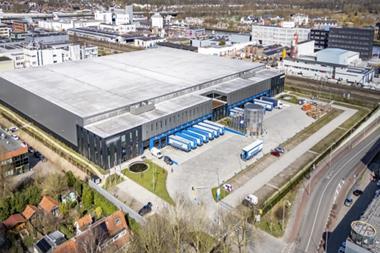Pension funds are starting to make progress towards sustainable portfolios but they are still hampered by the absence of a clear cost benefit analysis. Richard Lowe reports
Sustainability has been on the agenda for property developers, fund managers and investors alike for some time. However, there seems to be a lot more talk compared with, say, two years ago. One investment manager recently admitted the current "myriad" of conferences and events dedicated to the subject had become somewhat dizzying.
It is perhaps not that surprising then that this year's MIPIM featured what the British Property Foundation dubbed "the first ever international sustainability forum" to be held at the annual trade fair in Cannes. Liz Peace, chief executive of BPF, chaired the session and agreed that the sustainability agenda is today moving faster than at any time in the past. She is not without her concerns, though.
"What worries me is we are spending far too much time tripping over each other, running competing conferences," she says. "We don't want to talk about it, we want to get on with it."
However, it is reassuring to think that the growing proliferation of sustainability conferences has probably less to do with industry players clamouring for the latest marketing opportunity, but rather more to do with an emerging recognition across the real estate sector that sustainability has real financial implications.
Once the issue of sustainability becomes less about conceptual or moral concerns and more about measurable factors that play a part in determining property values and investment performance, you can expect action from the industry. There seems to be an emerging consensus that sustainability will impact on values. When and in what way, however, is a matter for debate.
"Where we are at the moment as an industry is we all think this will affect values and may already be affecting values," says Andy Schofield, research manager at Henderson Global Investors.
Keith Bugden, director of development at Hermes Real Estate, the UK investment manager and wholly owned subsidiary of the BT Pension Scheme, offers an analogy of the current situation.
"There is a train steaming along and we know which direction it is heading in," he says. "We believe it is absolutely inevitable there will be an impact on value - both positive and negative. At the moment we can't actually quantify this, but we are undertaking a significant amount of work in the area."
And both fund managers are doing more than just talk about the value-related implications of sustainability. Schofield explains that Henderson's current UK portfolios are being assessed against "75 sustainability criteria" and the fund manager will also be looking at its European funds later in the year.
Hermes meanwhile has been working on its "responsible property investment agenda" for over a decade, but in more recent years has created its sustainability rating system (SRS) with which to assess currently held property assets against sustainable criteria.
Carl Bennett, head of research and strategy at Hermes Real Estate, explains: "We got to a point where we said it is all well and good having a sample portfolio and making it as green as possible, but in reality is it actually going to make a difference to our financial performance?
"We have to bear in mind it is not our money - it is our clients' money. While we may want to be market leaders in terms of being very green and very sustainable, ultimately it has to convert to better relative performance. About a year and a half ago we all bought into the concept that it is going to have an impact on performance."
The West Midlands Pension Fund has recently refurbished a major office block in Birmingham with ‘sustainable criteria', but Brian Bailey, director of pensions at the UK local authority pension scheme, believes sustainability can only be integrated into real estate investments on an ongoing basis, when and where opportunities present themselves.
"Buildings don't last forever and there is a constant need to refresh, refurbish and adapt," he says. "So, in a reasonably sized property portfolio there are a lot of opportunities on an ongoing basis to take these issues on board without it damaging your returns.
"These things are not going to happen over a one- or two-year period, but if you are looking at medium-to long-term and you start counting up the things that can happen, they are substantial."
The Universities Superannuation Scheme (USS) is often regarded as one of the most proactive UK pension funds on the topic of sustainability. The issue with specific regard to real estate has been on the agenda since 2002, according to Graham Burnett, head of property at the £30bn (€37bn) fund, when the first responsible property investment (RPI) policy document was put together.
Burnett reveals that "more resources" have been committed to the area over the last two years, as part of a process to update and refine the fund's RPI policy, including input from Upstream consultancy in particular. In this respect, USS has been collecting data on waste, energy and water consumption from its direct property holdings for some time and is at the stage where it can "set some meaningful targets for reduction in all those areas".
Regarding USS's indirect investments, Burnett admits that the pension fund's "ability to influence" is less than it is on the direct side. "We do take the opportunity to ask questions of the managers we deal with. My general perception is there is much more that can be done in that area. Some managers have their own corporate responsible investment policies, which do have regard to these issues, but a specific fund level strategy is not common."
That said, Burnett is aware of fund managers tackling the issue at a fund level and he speculates that there are probably others who are also doing so. "Perhaps what many are not doing is communicating it well enough," he reflects.
The real driving force for the ‘value case' of sustainable real estate is undoubtedly tenant demand. If employers begin to feel the need to occupy sustainable space the market will have to respond.
"What is driving tenants is corporate social responsibility, reduced energy costs and associating themselves with something clean, green and good," says Tim Mockett, managing director at Climate Change Capital, the specialist investment bank that is looking to move into the sustainable property market. "There are also softer staff issues: attracting and retaining smart, younger generations," he adds.
And a growing demand for sustainable features from tenants could theoretically see the emergence of a two-tier market, with sustainable properties commanding higher rents and poorly performing assets leaking value and becoming increasingly obsolescent.
Mocket says: "We see a trend emerging: a two-tier market where greener buildings will let faster, have lower depreciation, will be more liquid and ultimately will attract a premium yield."
A survey by developer Jones Lang LaSalle and workplace association CoreNet Global at the end of 2007 asked company executives from around the world - canvassing employers attending its summits in London, Melbourne, Denver and Singapore - whether they would pay a premium for sustainable real estate. Seventy-seven per cent said they would.
Another important driver to take account is emerging legislation and regulation from governments around the world. The EU Energy Performance in Buildings Directive (EPBD) has placed pressure on member states to improve the energy performance of buildings, including the requirement to introduce energy certification for buildings.
The UK recently introduced Energy Performance Certificates (EPC) for new residential developments and the construction, sale or rent of commercial real estate with a floor area of over 10,000m2. From July, EPCs will apply to commercial buildings with a floor space over 2,500m2 and by October all commercial properties will be affected.
Bugden claims that Hermes Real Estate was
the first major landlord in the UK to have all its properties assessed against the EPC regime ahead of the original deadline (which has since been moved back).
"To get those asset energy ratings on our desks six months in advance of the legislation gave us the opportunity to look at those ratings and to look at individual properties to see where there are opportunities to improve ratings, so that when the legislation does come into being we will have undertaken a comprehensive evaluation of our entire managed portfolio," he reveals.
Through its SRS system, Hermes Real Estate will adopt an "averaging-up approach", whereby each year it focuses on getting 20% or more of the portfolio "up to spec", Bennett explains. "We are not trying to change the whole portfolio overnight as this would be unrealistic."
An opportunity has already arisen for the fund manager to refurbish a property in the City of London, "moving it up a couple of ratings". Elsewhere, those properties that look set to receive low ratings and do not look financially viable to be improved could potentially be sold.
"We will focus on those buildings that fail to reach the set target levels for sustainability and that we feel cannot be converted," Bennett says. "We will look long and hard at them, on a performance and risk basis, to see if they are viable in our portfolio, because the intention is to get the whole portfolio moving up the curve."
Yet, while the arrival of EPCs in the UK is largely seen as a way of forcing the property industry to become more proactive in the area of energy efficiency, some are seeing potentially attractive investment and arbitrage opportunities arising as a direct result of the legislation.
Last December, Aberdeen Property Investors revealed that it was exploring the possibility of launching a UK property fund at some point in 2008. What was not made clear at the time, however, was that this might in fact be a sustainable fund. There have been sustainable fund launches in the past - the Green Development Fund, launched in 2006 by Hines and US pension fund CalPERS, was the first. More recently Kenmore Property Group and DTZ have announced plans to launch Sustento, a €750m pan-European sustainable fund - but Aberdeen's proposition is unusual in that it would look to capitalise on mispricing resulting from the EPC legislation.
"The legislation that is due to come in this year will create a situation where properties go out of favour - both with tenants, investors and potentially also financiers - as a result of which they are likely to suffer from a pricing reduction," explains Glenn Newson, a managing director at Aberdeen. "If investors are being selective as to which assets they acquire they are most likely to see that those are the ones they wish initially to avoid, which will create a mispricing opportunity for us to come in and acquire them."
The plan is to purchase assets that have suffered in value because they perform badly under the EPC regime, but which also have the potential to be retrofitted at a cost that makes their redevelopment profitable. "It is only a relatively small proportion of the buildings that suffer in pricing that are capable of being enhanced," Newson adds.
For the strategy to work it depends on the introduction of EPCs having a fairly quick impact on the market and Newson believes it will. "We think it will happen quickly on the basis that once the legislation is introduced it applies to every building that is bought, sold and let and therefore tenants will become aware of it very quickly," he says. "We don't see it as being something that will take a number of years to flow through into the system."
However, Charles Woollam, director at DTZ, does not believe the advent of EPCs will have an immediate effect, because there is no established cost-benefit analysis for paying a premium to occupy a building rated, say, C over another similar building rated F.
"If the hard pressed occupier has a choice of six buildings and they are all rated F-G, it doesn't given him any chance to do any pricing. If on the other hand he has two identical buildings next door to each other, both meeting his requirements in all other respects, and one was an A and one was an F, he might be prepared to offer more money for A. But only if the market was such that the landlord had to accept less for the building with lower energy efficiency."
More generally, Woollam believes sustainability and energy efficiency will become one factor of "quality", which along with "location" will remain the two main drivers of values.
"It would be very difficult to point at something like sustainability and say on its own it is going to add to or subtract from value. The idea of suddenly almost overnight a building that is less sustainable will suddenly become secondary and that a building just through sustainability will become prime just isn't right," he says.
Incentives and cohesion
At the British Property Federation's international sustainability forum at MIPIM in April, Peter Verwer, chief executive at the Property Council of Australia, voiced his concerns at the emergence of two myths surrounding sustainability in real estate.
The first is the notion that "going green" is effectively a win-win situation or "no-brainer" for property developers and investors, because sustainable features will reduce running costs and increase the capital values of buildings. The danger here, Verwer suggested, was that governments around the world would wrongly assume the industry does not need any further incentives to push the sustainability agenda forward.
Verwer was equally concerned that the real estate industry should not be held solely responsible for the growth in carbon emissions emanating from the built environment. In his view, the increase in carbon emissions was not really down to the real estate industry, but more generally due to the growth in economies, population and production. It is easy to forget that real estate developers have been cutting carbon emissions per square metre through technological innovation and better management long before sustainability took centre stage in the way it has today.
The issue is therefore double-edged: there is a need for what Verwer calls "appropriate incentives that more effectively transform market behaviour", but there is also a danger that "poorly conceived regulation" may stifle natural innovation already demonstrated by the industry.
In short, Verwer says, the costs of regulation should outweigh the benefits. "There should be an optimum approach," he says. "Increasing the stringency of the building codes is one way of tackling this issue, where you are removing or eliminating bad practices and raising the minimum standard. But you can only go so far - you can't regulate for best practice, generally. That is why there need to be incentives to transform the marketplace in an innovative manner."
It is in the area of existing buildings - which are estimated to produce 98% of real estate carbon emissions, the remainder coming from new developments - where regulatory incentives are required.
"It has been proved for new buildings, in some countries - Australia being one - that the investment market will pay for the technology that is going to make the buildings more efficient," he says. "The focus therefore must be on existing buildings. If we are serious about reducing carbon emissions, there needs to be a major strategic focus on existing buildings."
Ranald Boydell, sustainable development director at Kilmartin Property Group, believes there needs to be more cohesion between market forces and regulation. "We already have government legislation and we already have some market forces, but it is still not coming together," he says. "One of them by itself is not going to work. You need them both in unison."
Boydell cites the UK government's stamp duty relief for houses that are zero-carbon. For a residential property worth £500,000, (€633,000) the stamp duty relief would cover the cost of making it zero-carbon. However, the relative saving from stamp duty relief would not be enough when applied to an averagely priced home in the region of £150,000-£200,000.
"That is an example where the government regulation and the market are both saying they want to do something, but they are not being integrated," Boydell says.












